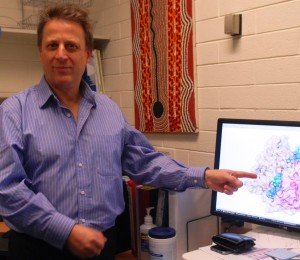
Dr Nikolai Petrovsky and a 3D protein model being used in the development of a possible Alzheimer’s disease vaccine.
In research findings just released in Nature’s Scientific Reports journal, Flinders University experts as part of a
With more than 48 million dementia cases in 2015, Alzheimer’s is emerging as one of the biggest cost to the world’s
The World Health Organisation has projected the total global societal cost of
Without a breakthrough treatment, the number of people living with dementia in Australia is expected to be almost 900,000 by 2050.
«If we are successful in
«Along with our rapidly ageing populations, we now know that the explosion in type 2 diabetes in the West is likely to further dramatically fuel the projected rise in the number of cases of dementia globally, with diabetes being the major risk factor for Alzheimer’s disease," Professor Petrovsky says.
The quest to develop treatments or a much anticipated cure for Alzheimer’s disease is costly and lengthy.
In the 10 years to 2012, 244 compounds were investigated in 413 clinical trials around the world, with only one new drug being approved for temporarily alleviating symptoms of the disease. That’s a success rate of 0.4%.
The scale of the dementia problem has seen the US Congress commit a further $US350 million to the National Institutes of Health (NIH) for research into Alzheimer’s disease, taking research funding in the US to more than $US1.3 billion this year.
With NIH and Alzheimer’s Association funding, the US researchers say they have developed an «exceptional» universal vaccine platform, called MultiTEP, to target the hallmark proteins, aberrant forms of AB and tau proteins.
β-amyloid (AB) is a protein found to be prominent in driving Alzheimer’s disease, but the accumulation of pathological tau also correlates with the formation of dementia in Alzheimer’s patients.
Using a combination of
Professor Michael Agadjanyan, head of IMM Department of Molecular Immunology, says the MultiTEP
She says the cooperative studies with National Institute of Aging IMM scientists and collaborators from UCI and the University of Southern California are working with experts from four companies to conduct
After completion of these
Vaxine is funded by the US NIH to develop novel compounds called adjuvants that play a critical role in maximising vaccine effectiveness. The Vaxine Advax™ adjuvant technology is a key component in the development of IMM’s Alzheimer’s vaccine
Source: http://blogs.flinders.edu.au/flinders-news/2016/07/13/progress-in-worlds-first-alzheimers-vaccine/

